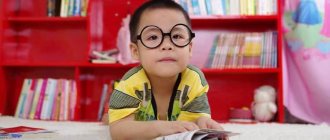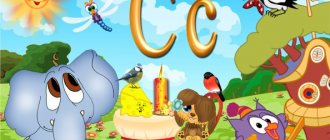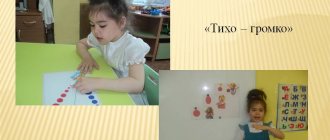Article:
Many children mistakenly pronounce the sound S, which is difficult for them, and other whistling sounds (s. z, z, z).
They may skip this sound or replace it with other sounds. In normal speech development, by the age of five, children correctly pronounce all the sounds of their native language (with the possible exception of the sound p, which may appear a little later - at 5.5 years). But now rarely do any children reach this norm. What is the reason? 1. Previously, in every kindergarten from the age of three until graduation from kindergarten, articulation gymnastics was regularly carried out with all children before breakfast, and in the evening - individual exercises with children who have difficulty pronouncing sounds. And this was not done by a speech therapist, but by an ordinary trained teacher! And these were not isolated complexes, exercises and games, but a strictly substantiated system for teaching speech and pronunciation of sounds. Because without a system, problems cannot be solved. Now this is history, and rarely can you find such a clearly and consistently built system of work for a teacher in sound pronunciation with children. This is probably why modern children have more problems with speech. 2. Nowadays, parents pay much less attention to their children’s speech. Often the child is only required to show something: “Where is Saturn? Where is Jupiter? Where is the Hermitage?”, and not the ability to express YOUR thoughts, YOUR feelings. Very often I hear: “Who cares what he says. The main thing is that you can understand it, that’s all!” But speech is a means of self-expression, communication, and knowledge. And the success of all types of human activity depends on its development. How to help a child if he pronounces the sound s and other whistling sounds incorrectly? Can parents help their baby? As is correct, parents wait until the age of 5 and then take the child to a speech therapist. Although sometimes one push is enough to evoke the correct sound in the child and help consolidate it in speech without waiting until the age of five. And this “push” should be done not at the age of 5-6, when they are already late, but much earlier - at the age of 4. And the most important thing is that to give such an impetus you don’t need to be an expert specialist at all! You just need to know the exact technology of teaching children sound pronunciation and its nuances. To develop in children the correct pronunciation of all the sounds of their native language, kindergartens conduct special sound pronunciation classes for all children (Note - not even in speech therapy kindergartens, but in the most ordinary kindergartens, sound pronunciation classes should be regularly held). If for some reason there are no such activities, then you can help your child at home. I know many mothers and grandmothers who, living far from a speech therapist, themselves coped with the problem of difficult sounds and helped their babies. And I know many educators who know how to prevent speech disorders and help a child speak correctly and learn to pronounce all the sounds of his native speech. We can all help the baby and show him the right path! But I want to warn you: • If the child does not have complex speech disorders, then the techniques that I will talk about in this article will be sufficient. And he will delight both you and himself with the correct sound s or z suddenly appearing in his speech. And there are many such children! The only task left is to make the correct pronunciation of the sound automatic, i.e. automate the correct pronunciation of a given sound. • But if all sounds are impaired in a child, he makes many grammatical mistakes, his speech is slurred, he speaks with difficulty, then you cannot do without a speech therapist. And the sooner you contact a specialist, the better the results will be. •All articulation exercises are useful not only for children whose sound pronunciation is impaired, but for all preschoolers, because they develop the articulatory apparatus, make it more mobile, flexible, and learn to control it consciously.
STAGES OF WORK ON SOUND.
Working on a new sound that a child pronounces incorrectly includes a number of stages: 1. Clarifying the movements of the organs of the articulatory apparatus necessary to pronounce a given sound, training the movements of the articulatory apparatus - articulatory gymnastics, 2. Appearance of the sound - production of the sound, 3. Mastery of the sound - consolidating the correct pronunciation of sounds in the child’s speech (in isolation, in syllables, in words, in phrases and texts - poems, stories, games, nursery rhymes). I will tell you about all these stages in more detail.
Songs for sound automation
I decided to make a small addition to Elena’s article. I love music very much, and therefore I always like to sing with children in my classes. Children enjoy repeating words with the desired sound many times in songs. Therefore, I have selected simple songs with the sound Sh for you and your children.
Start with songs in which you only need to pronounce syllables with the sh sound. Next, use songs with words that contain the sound Ш. Let the child finish and sing along these words from the text. And when he already speaks the sound Ш well enough, you can use tongue twisters or complex songs (for example, the song “Horses”).
Song - a pure saying for automating the correct pronunciation of the sound Ш in syllables
Shi-shi-shi-shi, how good the candies are, Sho-sho, sho-sho, wash your hands well, Shu-shu, shu-shu, I’ll invite you to the table, Sha-sha, sha-sha we’ll eat slowly.
Song "Horses"
In the song we automate the correct pronunciation of the sound Ш in phrases.
FIRST STAGE. ARTICULATION GYMNASTICS FOR WHISTLING SOUNDS (S, Sь, Z, ZZ, Ts)
As a rule, in a child who does not speak the sound s or pronounces it incorrectly, the sound pronunciation of other whistling sounds is also impaired (whistle sounds include the sounds s, з, ц and the soft version of the sounds - сь, зь). One of the reasons for incorrect pronunciation of sounds is insufficient mobility of the organs of the articulatory apparatus. Therefore, for correct pronunciation, special “regular exercise” is needed - articulatory gymnastics. The complex of articulatory gymnastics combines exercises that prepare strictly defined movements of the articulatory apparatus and the positions of the tongue and lips necessary for a given group of sounds and produce the correct air stream. Therefore, I really do not recommend that mothers, fathers, grandmothers, and grandfathers come up with their own articulation gymnastics complexes from different books and from the Internet. After all, all articulation gymnastics complexes are by no means composed randomly! It is impossible to form movements that are opposite to each other at the same time, therefore, in the complex of articulatory gymnastics, all exercises complement each other and are aimed at one goal - one group of sounds! Articulation gymnastics should be performed daily without breaks. The most convenient time is before breakfast in the morning. Carrying out such gymnastics requires only 3-5 minutes of your time. Each time, articulatory gymnastics is carried out in a playful way - in the form of a fairy tale or story, accompanied by exercises. This is where your imagination is welcome - you can come up with any plot in which you include these exercises, and change the plot and characters in accordance with the interests of your baby!
TIPS FOR CONDUCTING ARTICULATIVE GYMNASTICS - THIS IS IMPORTANT TO KNOW AND DO:
• Usually 2-3 exercises are performed at a time. Each exercise is performed multiple times. • If you add a new exercise to the complex, then there is only one, and all other exercises should be already familiar to the child by this time. • If a child finds it difficult to do old familiar exercises, then a new exercise is not introduced, but the old ones are reinforced. But consolidation occurs in a new form for the child - in a new plot, with new characters. • Articulation gymnastics should be done while sitting in front of a mirror - you sit next to the child facing the mirror and show all the movements, the child can clearly see your face. • It is imperative to monitor the symmetry of the face when performing gymnastics movements (the child’s movements must be symmetrical to the left and right half of the face). This is clearly visible to the child in the mirror, and he can track whether he is performing the movement correctly. • During articulatory gymnastics, it is necessary to monitor the accuracy, smoothness of movements, give the child clear criteria for the correctness and incorrectness of performing the exercise, correct his mistakes, monitor the absence of unnecessary side movements, a good pace of gymnastics and the ability to move from one movement to another. If you simply carry out the exercises formally, then their implementation is useless or of little use! After all, articulation gymnastics is not called that for nothing. This is truly “gymnastics”, in which correct movements are important, and not just playing with the tongue! By analogy: if you just lazily twirl your arms, it will not be physical education or fitness and will not have a good result for your health! It’s the same in articulation gymnastics. What is important for the result is the quality of the movements, and not any movement in itself. • Articulation gymnastics exercises, if performed correctly and accurately, are not easy for most children. Therefore, do not scold your child under any circumstances, do not grieve that he does not succeed the first time. Everything needs to be learned! And there is one law of life - everything that is developed develops! Therefore, everything is still ahead of you! Praise your baby for what he is already doing - you can already make your tongue wide, your tongue has already begun to move quickly, etc.
The preparatory complex of articulatory gymnastics includes exercises necessary for pronouncing any sounds. It is with this preparatory complex that it is best to start practicing articulatory gymnastics in kindergarten or at home. The basic version of this complex, which you can start doing at home: • Smile and keep your lips in a smile. In this case, the front teeth are exposed and clearly visible. • Tube. Pulling the lips forward with a tube. With this movement, only the lips move! • Ring. Ring-shaped lips. • Alternation: smile – ring – tube. • Calm opening and closing of the mouth, lips in a smile. There should be no other unnecessary movements! • The tongue is wide. • The tongue is narrow. • Alternation: wide tongue – narrow tongue. • Lifting the tongue by the upper teeth. • Alternating upward and downward movements of the tongue. •Alternating movements of the tongue with the tip of the tongue lowered down: move the tongue deeper into the mouth - bring it closer to the teeth.
If these movements are easy for the child, then you can immediately move on to the complex for whistling sounds. If there are difficulties, then you need to train the basic movements from the preparatory complex. If a child cannot do the exercise with alternating “smile - ring - tube”, then I highly recommend consulting with a speech therapist.
A COMPLEX OF ARTICULATION EXERCISES FOR WHISTLING SOUNDS S. Z, C (DEVELOPED BY FOMICHEVA M. V.).
Helpful Tips:
- In each exercise, I give a description of the movements and typical mistakes (see “What to pay attention to”). After the description you will find videos of all exercises.
- First, do all these exercises yourself in front of the mirror, paying attention to all the nuances, master them, and then learn them with your children.
- Never scold a child for a mistake, just show them again the correct version of the exercise, focusing on the necessary nuance, describe to the child in words how to perform the movements, what to watch for. Children are completely calm about the “funny tongue’s mistakes” and are happy to “teach” him to do the movements correctly.
EXERCISE 1. PUT THE BALL INTO THE GATE.
Our task: in this exercise the child will learn to direct a long, directed stream of air. Performing the exercise: Place two cubes on the table - these are gates. And next to the gate on the table in front of the child, place a cotton ball. The child stretches his lips forward with a tube, blows on the ball and tries to drive it into the gate made of cubes. What you need to pay attention to: • Do not puff out your cheeks! The baby can hold them with his hands to control himself. • The air stream should be long and without interruptions - one long exhalation.
EXERCISE 2. PUNISH YOUR Naughty Tongue.
Our task: to teach the child to keep his tongue wide and relaxed. And continue to produce a directed air stream. Performing the exercise: The child, opening his mouth slightly, puts his tongue on his lower lip and, smacking his lips, says five-five-five. He then opens his mouth and keeps his tongue relaxed, wide and resting on his lower lip. I don’t like to “punish” the tongue with children, which is already trying its best to practice, so I do this exercise with the kids in a different plot - the tongue rests and sings the song five-five-five. Or I suggest the child massage his tongue: five-five-five. You can come up with your own plot. What you need to pay attention to: • The lower lip should not curl up. • The edges of the tongue touch the corners of the mouth - the tongue is really very wide. • We pat the tongue with our lips several times during one exhalation, while the air stream flows smoothly, without interruption, without holding our breath. • A child can check the correctness of the exercise in this way: bring a piece of cotton wool to his mouth, and it will deflect. Children always really like this kind of self-test.
EXERCISE 3. WIDE TONGUE – PANCAKE.
Our task: we will teach the child to hold his tongue in a calm, relaxed state. Performing the exercise: You need to smile, put the wide front edge of your tongue on your lower lip and hold it in this state for a count of one to five to ten. Try it yourself first! What you need to pay attention to when watching the exercise in the mirror: • The lips should not be in a tense smile - a grimace, they should be relaxed in a smile. • The lower lip should not curl up. • The tongue should not “run away” far - it simply covers the lower lip. • The lateral edges of the tongue touch the corners of the mouth - it is relaxed. • If the exercise does not work, then you need to continue doing the previous one - “punish the tongue.” And return to this exercise later.
EXERCISE 5. WHO WILL DRIVE THE BALL FURTHER?
Our task is to practice the correct air stream - the air goes in the middle of the tongue, the air stream is smooth, long, continuous. Performing the exercise: You will need cotton wool, which we will try to drive away. Fleece is our “ball”. You need to smile and place the wide front edge of your tongue on your lower lip. Next, pronounce the f sound for a long time. And blow the cotton wool onto the opposite edge of the table. What you need to pay attention to: • The lower lip should not be pulled over the lower teeth. • Do not puff out your cheeks! • You need to pronounce the sound f, not x - it is with the sound f that the air stream is narrow, as we need.
EXERCISE 6. BRUSHING YOUR TEETH.
Our task: we will teach the child to hold the tip of the tongue behind the lower teeth - this is required to pronounce whistling sounds. Performing the exercise: Smile, open your mouth slightly. Use the tip of your tongue to brush your lower teeth. First move your tongue from side to side, and then from bottom to top. What you need to pay attention to: • Lips in a smile and motionless during the entire exercise. • When moving from side to side, the tongue is at the gums and not at the top edge of the teeth. • When moving from bottom to top, the tip of the tongue should be wide and move upward from the root of the teeth.
Sometimes adults find articulation gymnastics boring and uninteresting. But not for children! I know from my own experience that children really like to look at themselves in the mirror, “learn their naughty tongue” and improve the technique of doing the exercise. And to all children! And if the plot of the exercises is changed, then the interest in them always remains very high, and there is a kind of intrigue - what will be new this time? After all, the baby himself clearly sees his results, sees that every time he makes the movement better and better, more and more accurate. And in this way the baby explores himself, the structure of his body, which is also very exciting for preschoolers.
It is simply impossible to say in absentia how much time it will take for the preparatory work. For one child three times is enough, for another - a week, for a third - a month. But the better the organs of the articulatory apparatus are developed, the faster the baby will learn to pronounce all sounds correctly. Therefore, there is no need to waste time on this and rush!
Disturbances in the pronunciation of hissing sounds in children:
First. The absence of hissing sounds in speech or their replacement with the sound t (instead of the word “bear” the child pronounces “mika”, instead of the word “thorn” the child pronounces “type” - replaces it with t).
Possible reasons for this distortion of the sh sound are early age or impaired phonemic hearing.
Second. Replacements with f (fifka - bump).
Possible causes of sound distortion:
violation of phonemic perception., too active lip work, shortened sublingual frenulum. This replacement is called labiodental sigmatism.
Third. Replacing the sound sh with the sound s (for example, instead of “went” the child pronounces “sla”). This replacement is called whistling sigmatism.
Possible reasons for sh sound distortion:
violation of phonemic awareness. When correcting, it is necessary to teach the child to distinguish between whistling and hissing sounds!
Fourth. Lisp. This is due to the fact that, in contrast to the normal position of the organs of articulation, the tongue is pushed between the upper and lower incisors, forming a flat gap with them, the back is lowered and does not form the back of the scoop. The air stream when you bring your palm to your mouth is weak and scattered.
Possible reasons for sh sound distortion:
shortened hyoid ligament, making it difficult to lift the tongue to the palate; high and narrow hard palate. This replacement is called interdental sigmatism.
Fifth. Lateral sigmatism.
In this case, in the words he pronounces, instead of the sound sh
a peculiar squelching sound is heard. One of the corners of the lips is slightly lowered or retracted, there may be a slight shift of the lower jaw to the left or right, the lateral edges of the tongue are also lowered. When you bring your palm to your mouth, the air stream goes to the side (left or right) or comes out along both edges of the tongue, while normally the air stream should go strictly in the middle of the tongue.
Possible causes of sound distortion:
weakness of the muscles of one half of the tongue; lateral open bite.
Sixth. Nasal sigmatism.
In this case, the sound w is replaced by snoring (in the nose) or a sound similar to the deep sound x with a nasal connotation. In contrast to normal articulation, the organs of speech occupy a neutral position, the tongue is lowered down and pulled into the depths of the mouth, the back of the tongue is raised up, connecting to the soft palate, the lateral edges are lowered down. The air stream exits through the nasal cavity and not from the mouth.
Cause of sound distortion
: is excessive tension on the back of the tongue.
SECOND PHASE. SOUND PRODUCTION.
At the second stage, those children who correctly pronounce the sound s clarify its articulation and pronunciation, and consolidate their skills. The same children who did not know how to pronounce it learn to pronounce this sound - “whistle”. It is very important that the child is aware of the correct articulation of sound and can check himself. This is possible from the age of 4. And in classes on speech development, all children are taught this (at least, they should be taught even in the most ordinary kindergarten). Why do children with good sound pronunciation need this knowledge and skills? To develop their ability to consciously control the organs of the articulatory apparatus, to clarify and consolidate correct pronunciation, for clearer and faster operation of the articulatory organs, for good mobility of the organs of the articulatory apparatus. All these skills develop gradually and require training.
At the age of 4, a child learns how teeth, lips, and tongue work when pronouncing sounds in the form of a fairy tale - the game “Tales of the Merry Tongue.”
From the age of 5, you can explain to children the correct articulation of sound in the form we are familiar with (without a fairy tale) and ask the child questions: “How does the mouth work? What does the tongue do”, etc. In older preschool age, it is already important not only to make a movement and be able to talk about the correct execution of the exercise, but also to monitor the smoothness and accuracy of the movements, the quick switching to a new movement, and the ease of movements.
Articulatory gymnastics with children of any age can be completed with an exercise or game with onomatopoeia with a given sound, which you will find below.
When producing a sound, the baby also learns the correct articulation of the sound.
CORRECT ARTICULATION OF SOUND C.
When correctly pronouncing a sound with: • The mouth smiles (the corners of the mouth are slightly drawn back), • The teeth are closed, • The tip of the tongue rests on the lower incisors (i.e., it is located below, not at the top), • The anterior part of the back of the tongue is close to the alveoli and forms a gap with them (children know the alveoli as “tubercles” on the palate, at the top of the mouth), • In the middle of the tongue, when pronouncing a sound, a groove is formed through which air flows. • Unlike hissing sounds, when making whistling sounds the air stream is cold! In order to determine which stream of air is coming from the mouth, you need to bring your hand to your mouth, palm down. Pronounce the sound Ш yourself in this position, and then the sound S, and you will see the difference. You can show your baby this difference by blowing on his hand while pronouncing these two sounds. And then he himself will be happy to experiment to see how it works out for him - a cold stream of air or not.
For four-year-old children, you can practice the sound C in the form of a game. Invite your child to ride a bike. To do this, we need to inflate the tires that are slightly deflated with air. We will work with the pump and inflate the tires with air: sssss. Show yourself how the “pump works” - sss (show the articulation of this sound so that the child can clearly see your face). Ask your child: what is the position of the lips when the pump whistles? (In a smile). Are teeth visible? (Yes). Where is the tip of the tongue? (Below, hidden behind his lower teeth). What kind of air is coming in - cool or hot? (Cool) – bring the back of your hand to your mouth. Compare with the sound X - is the air warmer with the sound X or the sound of the pump C? Invite your child to “take the pump” (pantomime - an imaginary action) and “pump up the tires” - whistle ssss. Very often, even such clarification of the correct sound pronunciation of the sound C in the game “Pump” is enough for a four-year-old child to begin to pronounce the sound correctly!
It happens that “playing the pump” is not enough and you need to clarify the articulation of sound individually, in front of a mirror. When making a sound by imitation, you can invite the baby to blow on his slightly protruding wide tongue, imitating you. After this, you need to move your tongue behind your lower teeth. “Look where my tongue is. Do you see the teeth? Do the same. Smile so your teeth are visible. Press your wide tongue against your front teeth at the top. Well done! Now cover your mouth and let's blow. Raise your hand to your chin – can you feel the air flowing?” Place the cotton wool on the child's chin so that a stream of air hits it. If the child blows weakly, then ask him to blow harder, but do not puff out his cheeks. So, by imitation, the child will get the correct sound s. Repeat this sound 5-6 times with pauses.
You should not expect that the sound C, which appears through imitation, will immediately appear in the child’s speech. For a child, this is just the sound of a pump in a game!
Correct pronunciation of the sound "sh":
When the sound is sh
pronounced correctly
- lips
are rounded and slightly extended forward; - the teeth
are close together, but not touching; - the tongue
takes the shape of a cup, its tip touching the tubercles behind the upper teeth (alveoli); the air stream is strong, warm, and comes out in the middle of the tongue.
Education w
and
z
differs only in the presence or absence of a voice, that is, the sounds
sh
and
z
are pronounced almost identically, only
sh
is voiceless, and
z
is voiced.
If a child has learned to pronounce the sound sh correctly ,
When you add a voice,
it
will work automatically.








